Strategic Management Report: Automotive Industry Analysis and Strategy
VerifiedAdded on 2020/05/16
|9
|2278
|152
Report
AI Summary
This report provides a strategic management analysis of the automotive industry, focusing on the application of Porter's Five Forces to understand the competitive landscape. The analysis examines the bargaining power of suppliers and buyers, the threat of substitutes and new entrants, and the rivalry among competitors, specifically within the context of the growing electric vehicle market. The report also compares the competitive advantages of established automakers like Mercedes and BMW with the emerging electric vehicle sector, highlighting factors such as brand reputation, design, post-sales service, and research and development. It concludes by emphasizing the importance of innovation and strategic partnerships in gaining a sustainable competitive advantage in the rapidly evolving automotive industry. The report draws upon various academic sources to support its findings and provides a comprehensive overview of the industry's strategic challenges and opportunities.
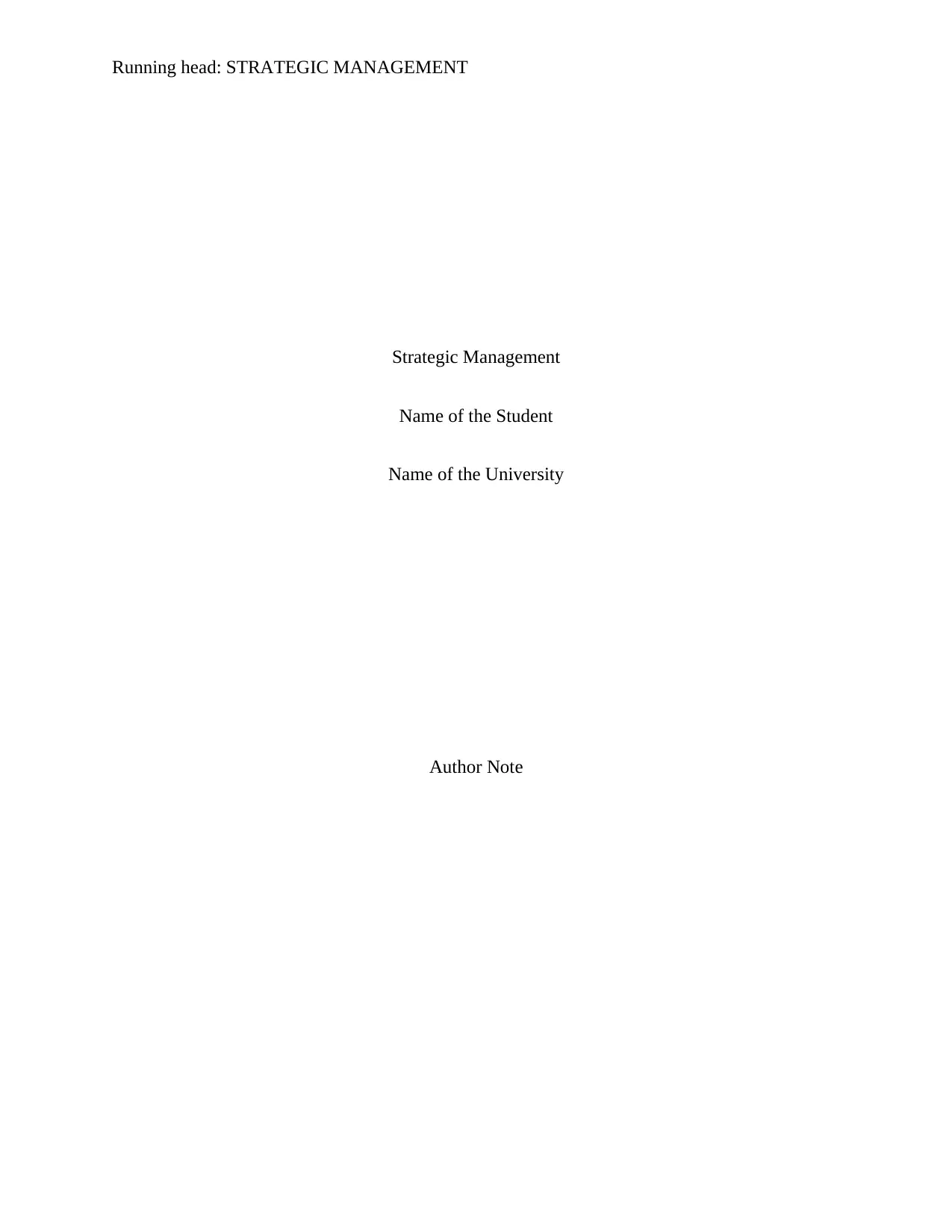
Running head: STRATEGIC MANAGEMENT
Strategic Management
Name of the Student
Name of the University
Author Note
Strategic Management
Name of the Student
Name of the University
Author Note
Paraphrase This Document
Need a fresh take? Get an instant paraphrase of this document with our AI Paraphraser
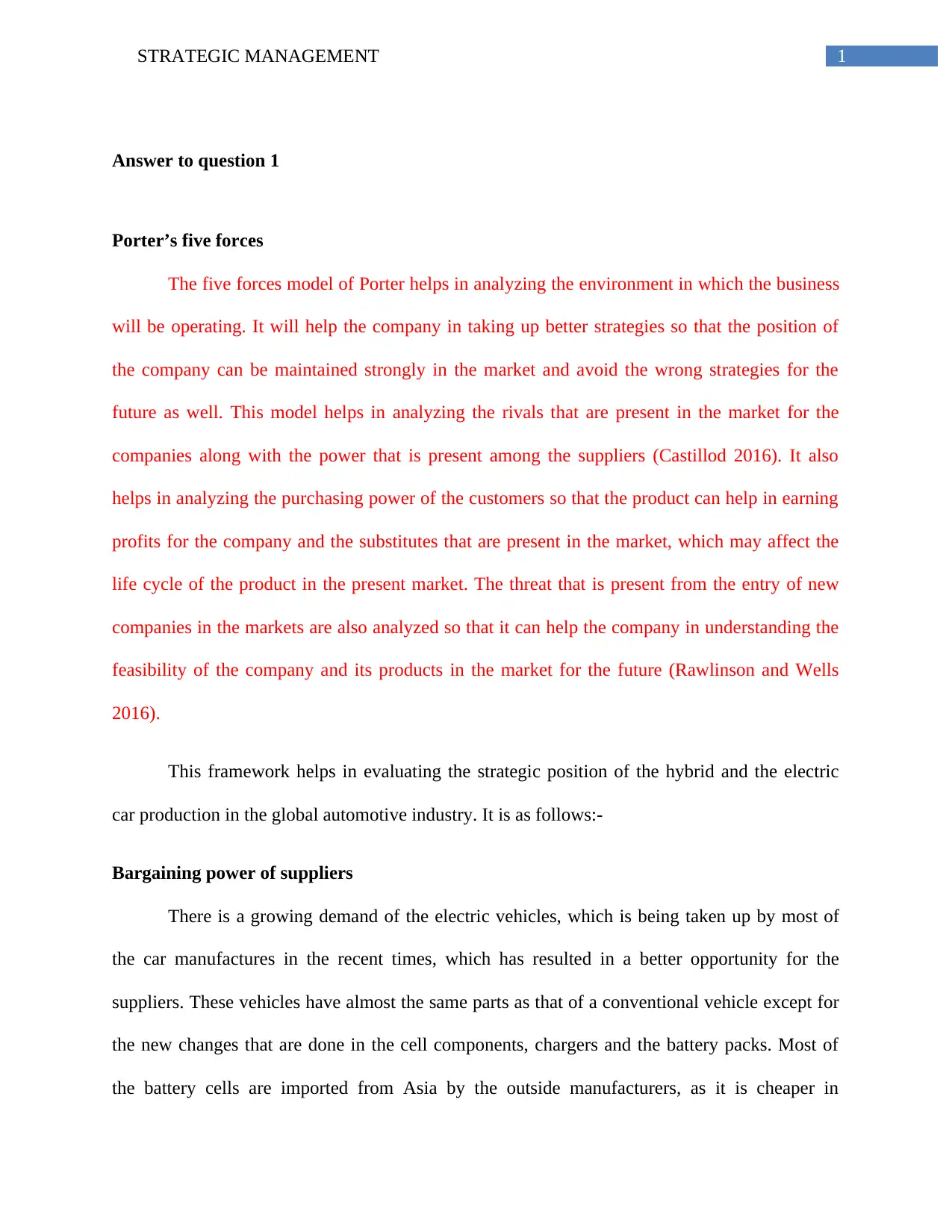
1STRATEGIC MANAGEMENT
Answer to question 1
Porter’s five forces
The five forces model of Porter helps in analyzing the environment in which the business
will be operating. It will help the company in taking up better strategies so that the position of
the company can be maintained strongly in the market and avoid the wrong strategies for the
future as well. This model helps in analyzing the rivals that are present in the market for the
companies along with the power that is present among the suppliers (Castillod 2016). It also
helps in analyzing the purchasing power of the customers so that the product can help in earning
profits for the company and the substitutes that are present in the market, which may affect the
life cycle of the product in the present market. The threat that is present from the entry of new
companies in the markets are also analyzed so that it can help the company in understanding the
feasibility of the company and its products in the market for the future (Rawlinson and Wells
2016).
This framework helps in evaluating the strategic position of the hybrid and the electric
car production in the global automotive industry. It is as follows:-
Bargaining power of suppliers
There is a growing demand of the electric vehicles, which is being taken up by most of
the car manufactures in the recent times, which has resulted in a better opportunity for the
suppliers. These vehicles have almost the same parts as that of a conventional vehicle except for
the new changes that are done in the cell components, chargers and the battery packs. Most of
the battery cells are imported from Asia by the outside manufacturers, as it is cheaper in
Answer to question 1
Porter’s five forces
The five forces model of Porter helps in analyzing the environment in which the business
will be operating. It will help the company in taking up better strategies so that the position of
the company can be maintained strongly in the market and avoid the wrong strategies for the
future as well. This model helps in analyzing the rivals that are present in the market for the
companies along with the power that is present among the suppliers (Castillod 2016). It also
helps in analyzing the purchasing power of the customers so that the product can help in earning
profits for the company and the substitutes that are present in the market, which may affect the
life cycle of the product in the present market. The threat that is present from the entry of new
companies in the markets are also analyzed so that it can help the company in understanding the
feasibility of the company and its products in the market for the future (Rawlinson and Wells
2016).
This framework helps in evaluating the strategic position of the hybrid and the electric
car production in the global automotive industry. It is as follows:-
Bargaining power of suppliers
There is a growing demand of the electric vehicles, which is being taken up by most of
the car manufactures in the recent times, which has resulted in a better opportunity for the
suppliers. These vehicles have almost the same parts as that of a conventional vehicle except for
the new changes that are done in the cell components, chargers and the battery packs. Most of
the battery cells are imported from Asia by the outside manufacturers, as it is cheaper in
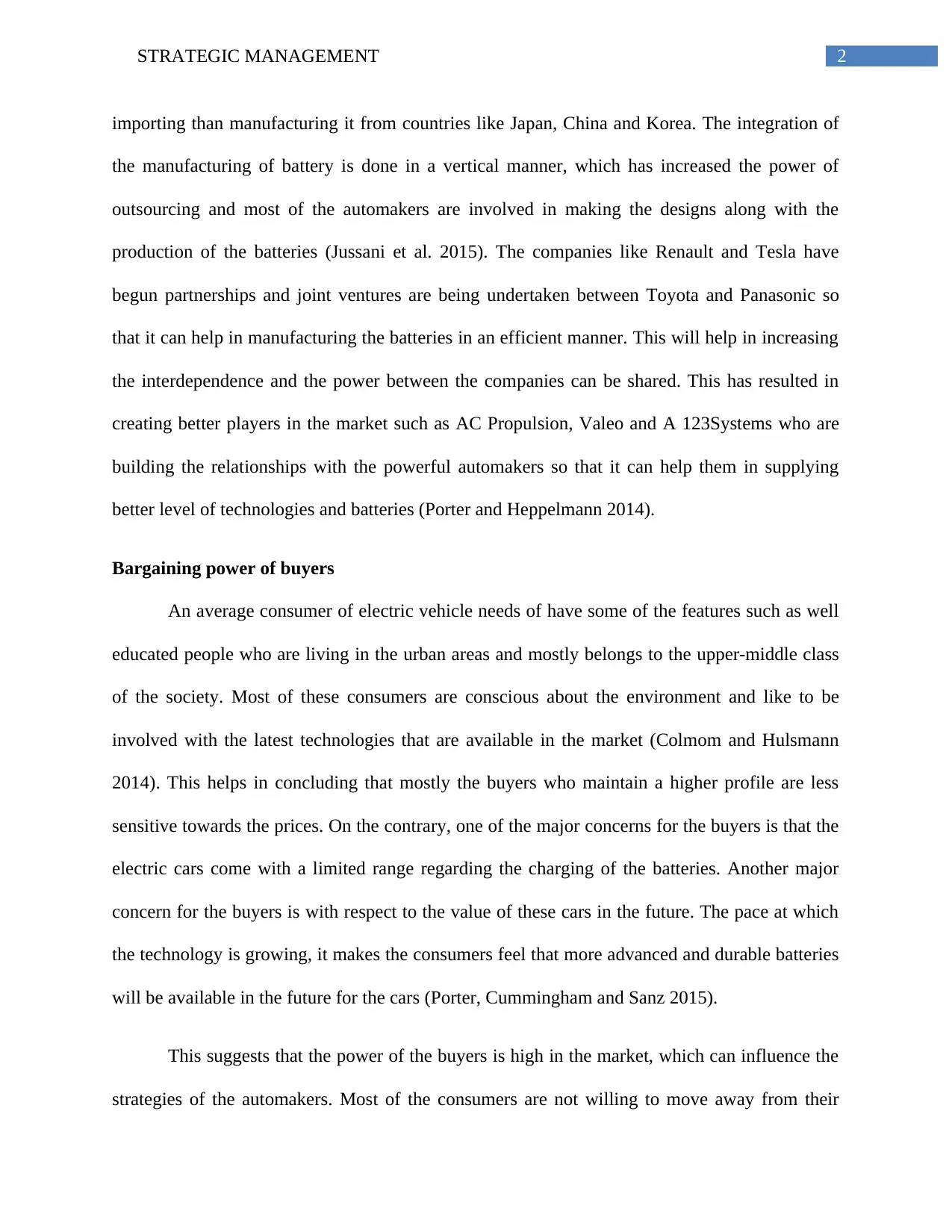
2STRATEGIC MANAGEMENT
importing than manufacturing it from countries like Japan, China and Korea. The integration of
the manufacturing of battery is done in a vertical manner, which has increased the power of
outsourcing and most of the automakers are involved in making the designs along with the
production of the batteries (Jussani et al. 2015). The companies like Renault and Tesla have
begun partnerships and joint ventures are being undertaken between Toyota and Panasonic so
that it can help in manufacturing the batteries in an efficient manner. This will help in increasing
the interdependence and the power between the companies can be shared. This has resulted in
creating better players in the market such as AC Propulsion, Valeo and A 123Systems who are
building the relationships with the powerful automakers so that it can help them in supplying
better level of technologies and batteries (Porter and Heppelmann 2014).
Bargaining power of buyers
An average consumer of electric vehicle needs of have some of the features such as well
educated people who are living in the urban areas and mostly belongs to the upper-middle class
of the society. Most of these consumers are conscious about the environment and like to be
involved with the latest technologies that are available in the market (Colmom and Hulsmann
2014). This helps in concluding that mostly the buyers who maintain a higher profile are less
sensitive towards the prices. On the contrary, one of the major concerns for the buyers is that the
electric cars come with a limited range regarding the charging of the batteries. Another major
concern for the buyers is with respect to the value of these cars in the future. The pace at which
the technology is growing, it makes the consumers feel that more advanced and durable batteries
will be available in the future for the cars (Porter, Cummingham and Sanz 2015).
This suggests that the power of the buyers is high in the market, which can influence the
strategies of the automakers. Most of the consumers are not willing to move away from their
importing than manufacturing it from countries like Japan, China and Korea. The integration of
the manufacturing of battery is done in a vertical manner, which has increased the power of
outsourcing and most of the automakers are involved in making the designs along with the
production of the batteries (Jussani et al. 2015). The companies like Renault and Tesla have
begun partnerships and joint ventures are being undertaken between Toyota and Panasonic so
that it can help in manufacturing the batteries in an efficient manner. This will help in increasing
the interdependence and the power between the companies can be shared. This has resulted in
creating better players in the market such as AC Propulsion, Valeo and A 123Systems who are
building the relationships with the powerful automakers so that it can help them in supplying
better level of technologies and batteries (Porter and Heppelmann 2014).
Bargaining power of buyers
An average consumer of electric vehicle needs of have some of the features such as well
educated people who are living in the urban areas and mostly belongs to the upper-middle class
of the society. Most of these consumers are conscious about the environment and like to be
involved with the latest technologies that are available in the market (Colmom and Hulsmann
2014). This helps in concluding that mostly the buyers who maintain a higher profile are less
sensitive towards the prices. On the contrary, one of the major concerns for the buyers is that the
electric cars come with a limited range regarding the charging of the batteries. Another major
concern for the buyers is with respect to the value of these cars in the future. The pace at which
the technology is growing, it makes the consumers feel that more advanced and durable batteries
will be available in the future for the cars (Porter, Cummingham and Sanz 2015).
This suggests that the power of the buyers is high in the market, which can influence the
strategies of the automakers. Most of the consumers are not willing to move away from their
⊘ This is a preview!⊘
Do you want full access?
Subscribe today to unlock all pages.

Trusted by 1+ million students worldwide
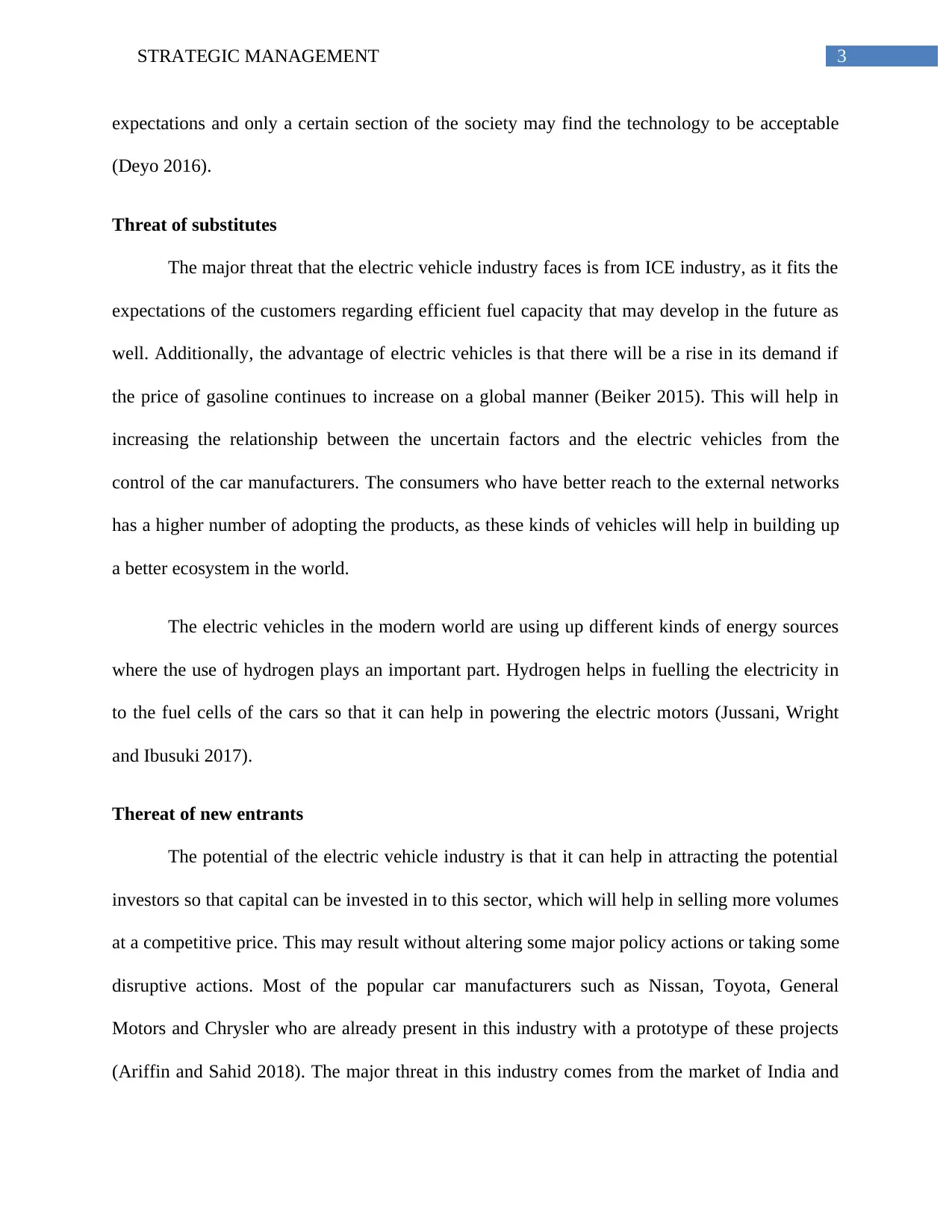
3STRATEGIC MANAGEMENT
expectations and only a certain section of the society may find the technology to be acceptable
(Deyo 2016).
Threat of substitutes
The major threat that the electric vehicle industry faces is from ICE industry, as it fits the
expectations of the customers regarding efficient fuel capacity that may develop in the future as
well. Additionally, the advantage of electric vehicles is that there will be a rise in its demand if
the price of gasoline continues to increase on a global manner (Beiker 2015). This will help in
increasing the relationship between the uncertain factors and the electric vehicles from the
control of the car manufacturers. The consumers who have better reach to the external networks
has a higher number of adopting the products, as these kinds of vehicles will help in building up
a better ecosystem in the world.
The electric vehicles in the modern world are using up different kinds of energy sources
where the use of hydrogen plays an important part. Hydrogen helps in fuelling the electricity in
to the fuel cells of the cars so that it can help in powering the electric motors (Jussani, Wright
and Ibusuki 2017).
Thereat of new entrants
The potential of the electric vehicle industry is that it can help in attracting the potential
investors so that capital can be invested in to this sector, which will help in selling more volumes
at a competitive price. This may result without altering some major policy actions or taking some
disruptive actions. Most of the popular car manufacturers such as Nissan, Toyota, General
Motors and Chrysler who are already present in this industry with a prototype of these projects
(Ariffin and Sahid 2018). The major threat in this industry comes from the market of India and
expectations and only a certain section of the society may find the technology to be acceptable
(Deyo 2016).
Threat of substitutes
The major threat that the electric vehicle industry faces is from ICE industry, as it fits the
expectations of the customers regarding efficient fuel capacity that may develop in the future as
well. Additionally, the advantage of electric vehicles is that there will be a rise in its demand if
the price of gasoline continues to increase on a global manner (Beiker 2015). This will help in
increasing the relationship between the uncertain factors and the electric vehicles from the
control of the car manufacturers. The consumers who have better reach to the external networks
has a higher number of adopting the products, as these kinds of vehicles will help in building up
a better ecosystem in the world.
The electric vehicles in the modern world are using up different kinds of energy sources
where the use of hydrogen plays an important part. Hydrogen helps in fuelling the electricity in
to the fuel cells of the cars so that it can help in powering the electric motors (Jussani, Wright
and Ibusuki 2017).
Thereat of new entrants
The potential of the electric vehicle industry is that it can help in attracting the potential
investors so that capital can be invested in to this sector, which will help in selling more volumes
at a competitive price. This may result without altering some major policy actions or taking some
disruptive actions. Most of the popular car manufacturers such as Nissan, Toyota, General
Motors and Chrysler who are already present in this industry with a prototype of these projects
(Ariffin and Sahid 2018). The major threat in this industry comes from the market of India and
Paraphrase This Document
Need a fresh take? Get an instant paraphrase of this document with our AI Paraphraser
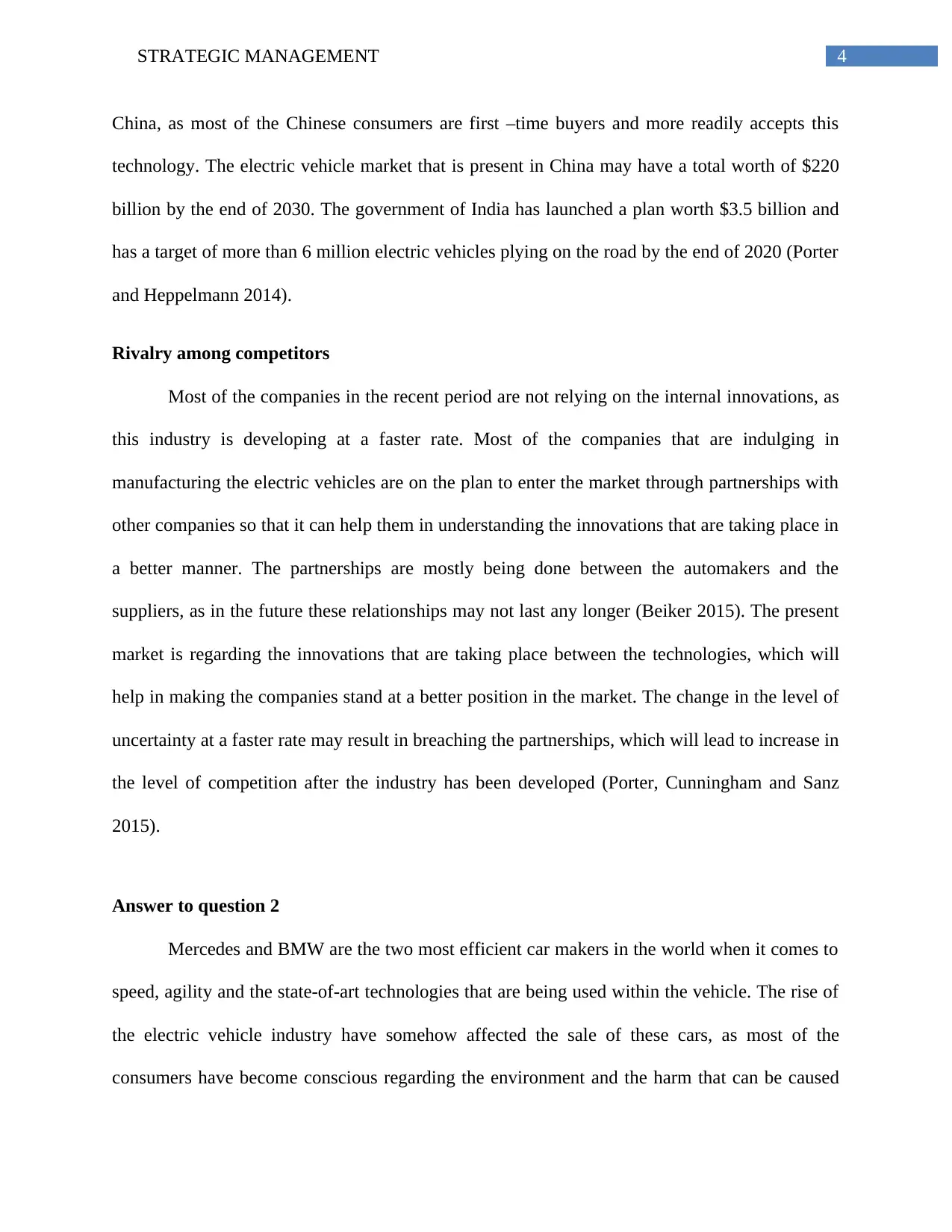
4STRATEGIC MANAGEMENT
China, as most of the Chinese consumers are first –time buyers and more readily accepts this
technology. The electric vehicle market that is present in China may have a total worth of $220
billion by the end of 2030. The government of India has launched a plan worth $3.5 billion and
has a target of more than 6 million electric vehicles plying on the road by the end of 2020 (Porter
and Heppelmann 2014).
Rivalry among competitors
Most of the companies in the recent period are not relying on the internal innovations, as
this industry is developing at a faster rate. Most of the companies that are indulging in
manufacturing the electric vehicles are on the plan to enter the market through partnerships with
other companies so that it can help them in understanding the innovations that are taking place in
a better manner. The partnerships are mostly being done between the automakers and the
suppliers, as in the future these relationships may not last any longer (Beiker 2015). The present
market is regarding the innovations that are taking place between the technologies, which will
help in making the companies stand at a better position in the market. The change in the level of
uncertainty at a faster rate may result in breaching the partnerships, which will lead to increase in
the level of competition after the industry has been developed (Porter, Cunningham and Sanz
2015).
Answer to question 2
Mercedes and BMW are the two most efficient car makers in the world when it comes to
speed, agility and the state-of-art technologies that are being used within the vehicle. The rise of
the electric vehicle industry have somehow affected the sale of these cars, as most of the
consumers have become conscious regarding the environment and the harm that can be caused
China, as most of the Chinese consumers are first –time buyers and more readily accepts this
technology. The electric vehicle market that is present in China may have a total worth of $220
billion by the end of 2030. The government of India has launched a plan worth $3.5 billion and
has a target of more than 6 million electric vehicles plying on the road by the end of 2020 (Porter
and Heppelmann 2014).
Rivalry among competitors
Most of the companies in the recent period are not relying on the internal innovations, as
this industry is developing at a faster rate. Most of the companies that are indulging in
manufacturing the electric vehicles are on the plan to enter the market through partnerships with
other companies so that it can help them in understanding the innovations that are taking place in
a better manner. The partnerships are mostly being done between the automakers and the
suppliers, as in the future these relationships may not last any longer (Beiker 2015). The present
market is regarding the innovations that are taking place between the technologies, which will
help in making the companies stand at a better position in the market. The change in the level of
uncertainty at a faster rate may result in breaching the partnerships, which will lead to increase in
the level of competition after the industry has been developed (Porter, Cunningham and Sanz
2015).
Answer to question 2
Mercedes and BMW are the two most efficient car makers in the world when it comes to
speed, agility and the state-of-art technologies that are being used within the vehicle. The rise of
the electric vehicle industry have somehow affected the sale of these cars, as most of the
consumers have become conscious regarding the environment and the harm that can be caused
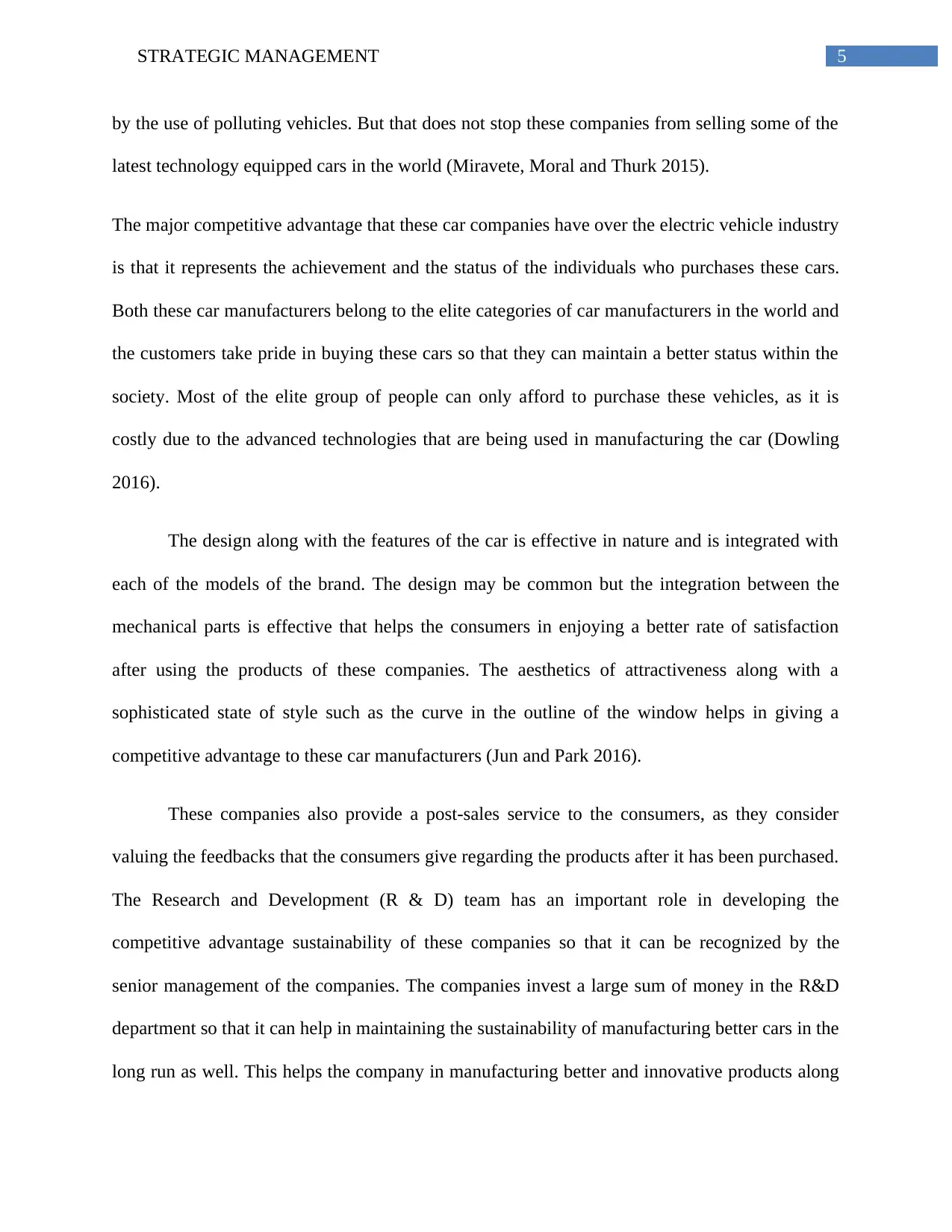
5STRATEGIC MANAGEMENT
by the use of polluting vehicles. But that does not stop these companies from selling some of the
latest technology equipped cars in the world (Miravete, Moral and Thurk 2015).
The major competitive advantage that these car companies have over the electric vehicle industry
is that it represents the achievement and the status of the individuals who purchases these cars.
Both these car manufacturers belong to the elite categories of car manufacturers in the world and
the customers take pride in buying these cars so that they can maintain a better status within the
society. Most of the elite group of people can only afford to purchase these vehicles, as it is
costly due to the advanced technologies that are being used in manufacturing the car (Dowling
2016).
The design along with the features of the car is effective in nature and is integrated with
each of the models of the brand. The design may be common but the integration between the
mechanical parts is effective that helps the consumers in enjoying a better rate of satisfaction
after using the products of these companies. The aesthetics of attractiveness along with a
sophisticated state of style such as the curve in the outline of the window helps in giving a
competitive advantage to these car manufacturers (Jun and Park 2016).
These companies also provide a post-sales service to the consumers, as they consider
valuing the feedbacks that the consumers give regarding the products after it has been purchased.
The Research and Development (R & D) team has an important role in developing the
competitive advantage sustainability of these companies so that it can be recognized by the
senior management of the companies. The companies invest a large sum of money in the R&D
department so that it can help in maintaining the sustainability of manufacturing better cars in the
long run as well. This helps the company in manufacturing better and innovative products along
by the use of polluting vehicles. But that does not stop these companies from selling some of the
latest technology equipped cars in the world (Miravete, Moral and Thurk 2015).
The major competitive advantage that these car companies have over the electric vehicle industry
is that it represents the achievement and the status of the individuals who purchases these cars.
Both these car manufacturers belong to the elite categories of car manufacturers in the world and
the customers take pride in buying these cars so that they can maintain a better status within the
society. Most of the elite group of people can only afford to purchase these vehicles, as it is
costly due to the advanced technologies that are being used in manufacturing the car (Dowling
2016).
The design along with the features of the car is effective in nature and is integrated with
each of the models of the brand. The design may be common but the integration between the
mechanical parts is effective that helps the consumers in enjoying a better rate of satisfaction
after using the products of these companies. The aesthetics of attractiveness along with a
sophisticated state of style such as the curve in the outline of the window helps in giving a
competitive advantage to these car manufacturers (Jun and Park 2016).
These companies also provide a post-sales service to the consumers, as they consider
valuing the feedbacks that the consumers give regarding the products after it has been purchased.
The Research and Development (R & D) team has an important role in developing the
competitive advantage sustainability of these companies so that it can be recognized by the
senior management of the companies. The companies invest a large sum of money in the R&D
department so that it can help in maintaining the sustainability of manufacturing better cars in the
long run as well. This helps the company in manufacturing better and innovative products along
⊘ This is a preview!⊘
Do you want full access?
Subscribe today to unlock all pages.

Trusted by 1+ million students worldwide
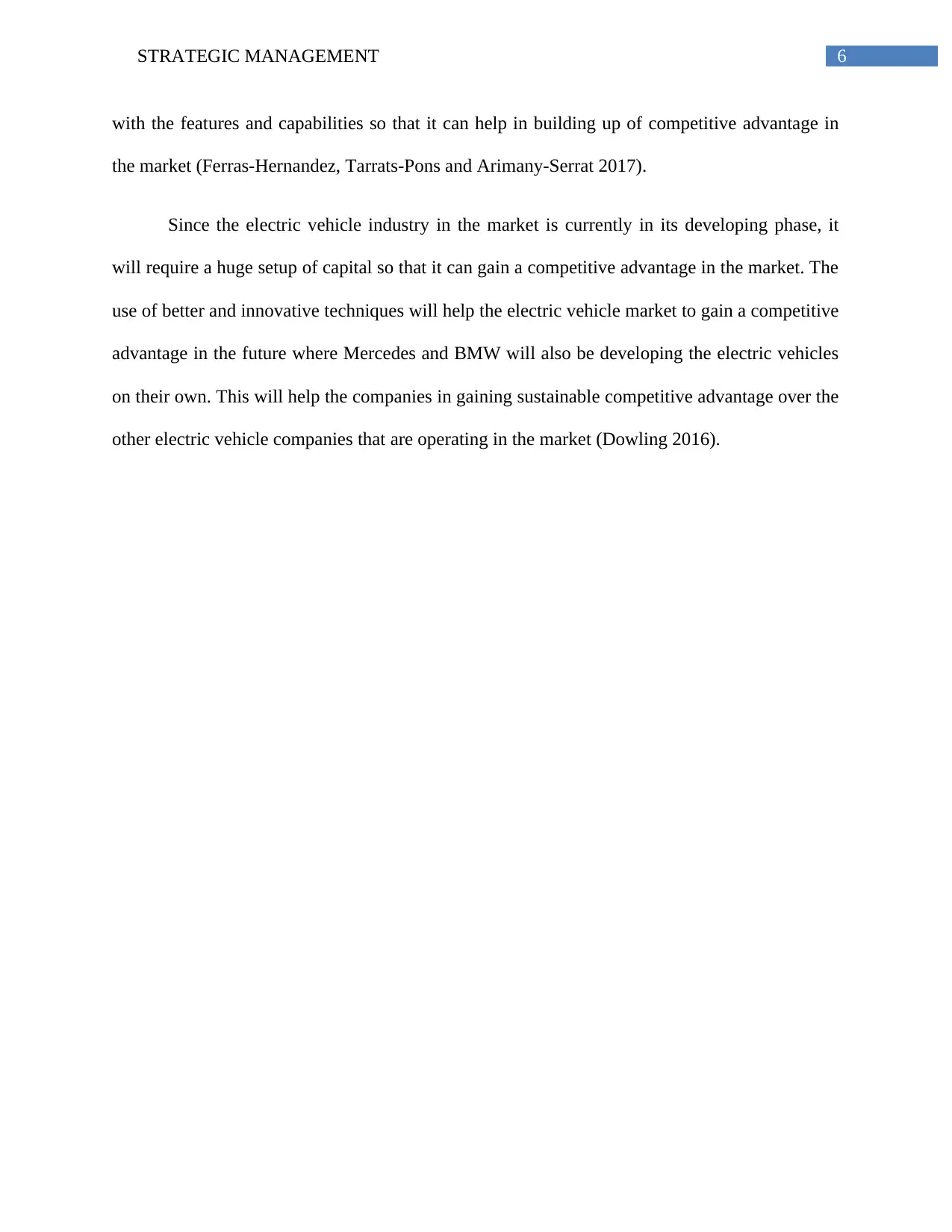
6STRATEGIC MANAGEMENT
with the features and capabilities so that it can help in building up of competitive advantage in
the market (Ferras-Hernandez, Tarrats-Pons and Arimany-Serrat 2017).
Since the electric vehicle industry in the market is currently in its developing phase, it
will require a huge setup of capital so that it can gain a competitive advantage in the market. The
use of better and innovative techniques will help the electric vehicle market to gain a competitive
advantage in the future where Mercedes and BMW will also be developing the electric vehicles
on their own. This will help the companies in gaining sustainable competitive advantage over the
other electric vehicle companies that are operating in the market (Dowling 2016).
with the features and capabilities so that it can help in building up of competitive advantage in
the market (Ferras-Hernandez, Tarrats-Pons and Arimany-Serrat 2017).
Since the electric vehicle industry in the market is currently in its developing phase, it
will require a huge setup of capital so that it can gain a competitive advantage in the market. The
use of better and innovative techniques will help the electric vehicle market to gain a competitive
advantage in the future where Mercedes and BMW will also be developing the electric vehicles
on their own. This will help the companies in gaining sustainable competitive advantage over the
other electric vehicle companies that are operating in the market (Dowling 2016).
Paraphrase This Document
Need a fresh take? Get an instant paraphrase of this document with our AI Paraphraser
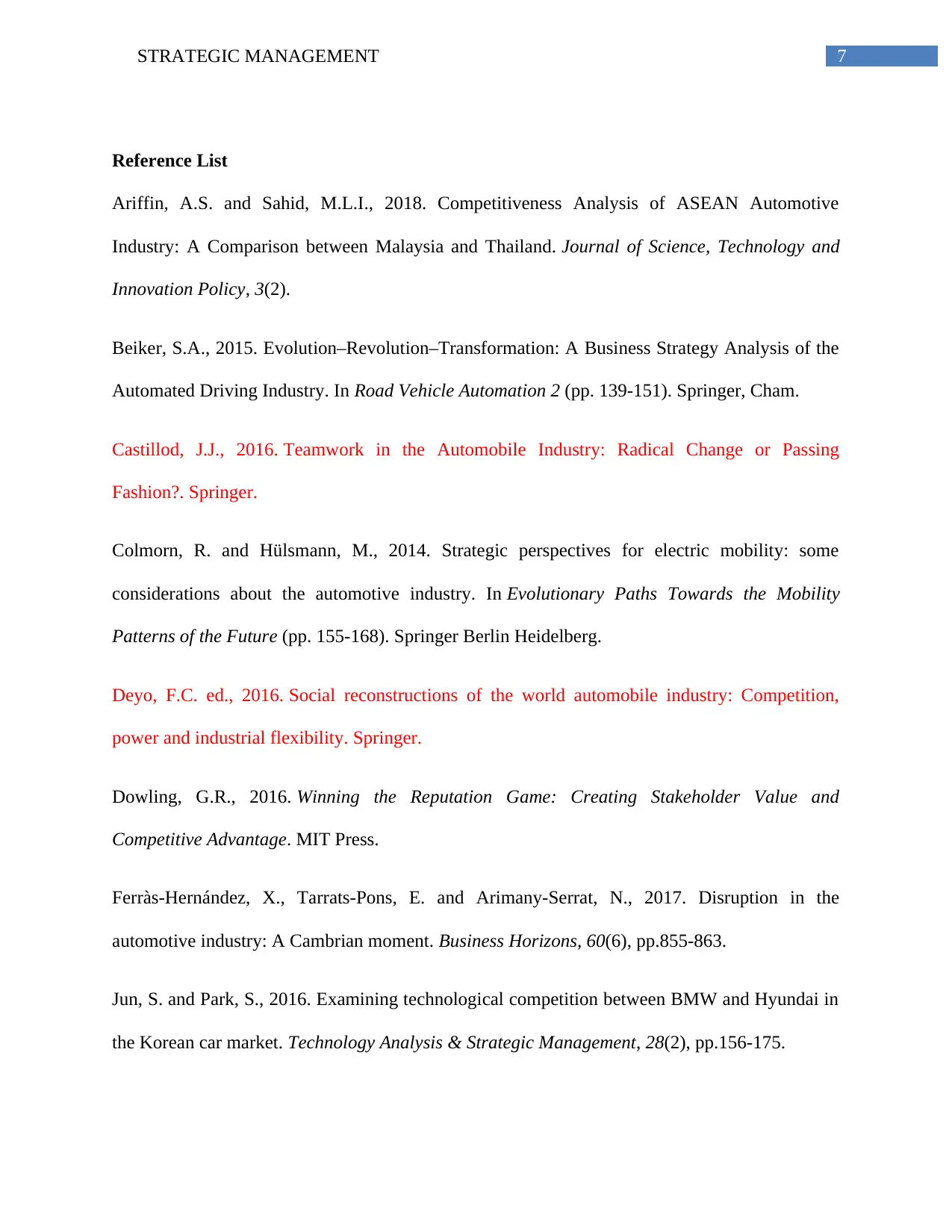
7STRATEGIC MANAGEMENT
Reference List
Ariffin, A.S. and Sahid, M.L.I., 2018. Competitiveness Analysis of ASEAN Automotive
Industry: A Comparison between Malaysia and Thailand. Journal of Science, Technology and
Innovation Policy, 3(2).
Beiker, S.A., 2015. Evolution–Revolution–Transformation: A Business Strategy Analysis of the
Automated Driving Industry. In Road Vehicle Automation 2 (pp. 139-151). Springer, Cham.
Castillod, J.J., 2016. Teamwork in the Automobile Industry: Radical Change or Passing
Fashion?. Springer.
Colmorn, R. and Hülsmann, M., 2014. Strategic perspectives for electric mobility: some
considerations about the automotive industry. In Evolutionary Paths Towards the Mobility
Patterns of the Future (pp. 155-168). Springer Berlin Heidelberg.
Deyo, F.C. ed., 2016. Social reconstructions of the world automobile industry: Competition,
power and industrial flexibility. Springer.
Dowling, G.R., 2016. Winning the Reputation Game: Creating Stakeholder Value and
Competitive Advantage. MIT Press.
Ferràs-Hernández, X., Tarrats-Pons, E. and Arimany-Serrat, N., 2017. Disruption in the
automotive industry: A Cambrian moment. Business Horizons, 60(6), pp.855-863.
Jun, S. and Park, S., 2016. Examining technological competition between BMW and Hyundai in
the Korean car market. Technology Analysis & Strategic Management, 28(2), pp.156-175.
Reference List
Ariffin, A.S. and Sahid, M.L.I., 2018. Competitiveness Analysis of ASEAN Automotive
Industry: A Comparison between Malaysia and Thailand. Journal of Science, Technology and
Innovation Policy, 3(2).
Beiker, S.A., 2015. Evolution–Revolution–Transformation: A Business Strategy Analysis of the
Automated Driving Industry. In Road Vehicle Automation 2 (pp. 139-151). Springer, Cham.
Castillod, J.J., 2016. Teamwork in the Automobile Industry: Radical Change or Passing
Fashion?. Springer.
Colmorn, R. and Hülsmann, M., 2014. Strategic perspectives for electric mobility: some
considerations about the automotive industry. In Evolutionary Paths Towards the Mobility
Patterns of the Future (pp. 155-168). Springer Berlin Heidelberg.
Deyo, F.C. ed., 2016. Social reconstructions of the world automobile industry: Competition,
power and industrial flexibility. Springer.
Dowling, G.R., 2016. Winning the Reputation Game: Creating Stakeholder Value and
Competitive Advantage. MIT Press.
Ferràs-Hernández, X., Tarrats-Pons, E. and Arimany-Serrat, N., 2017. Disruption in the
automotive industry: A Cambrian moment. Business Horizons, 60(6), pp.855-863.
Jun, S. and Park, S., 2016. Examining technological competition between BMW and Hyundai in
the Korean car market. Technology Analysis & Strategic Management, 28(2), pp.156-175.
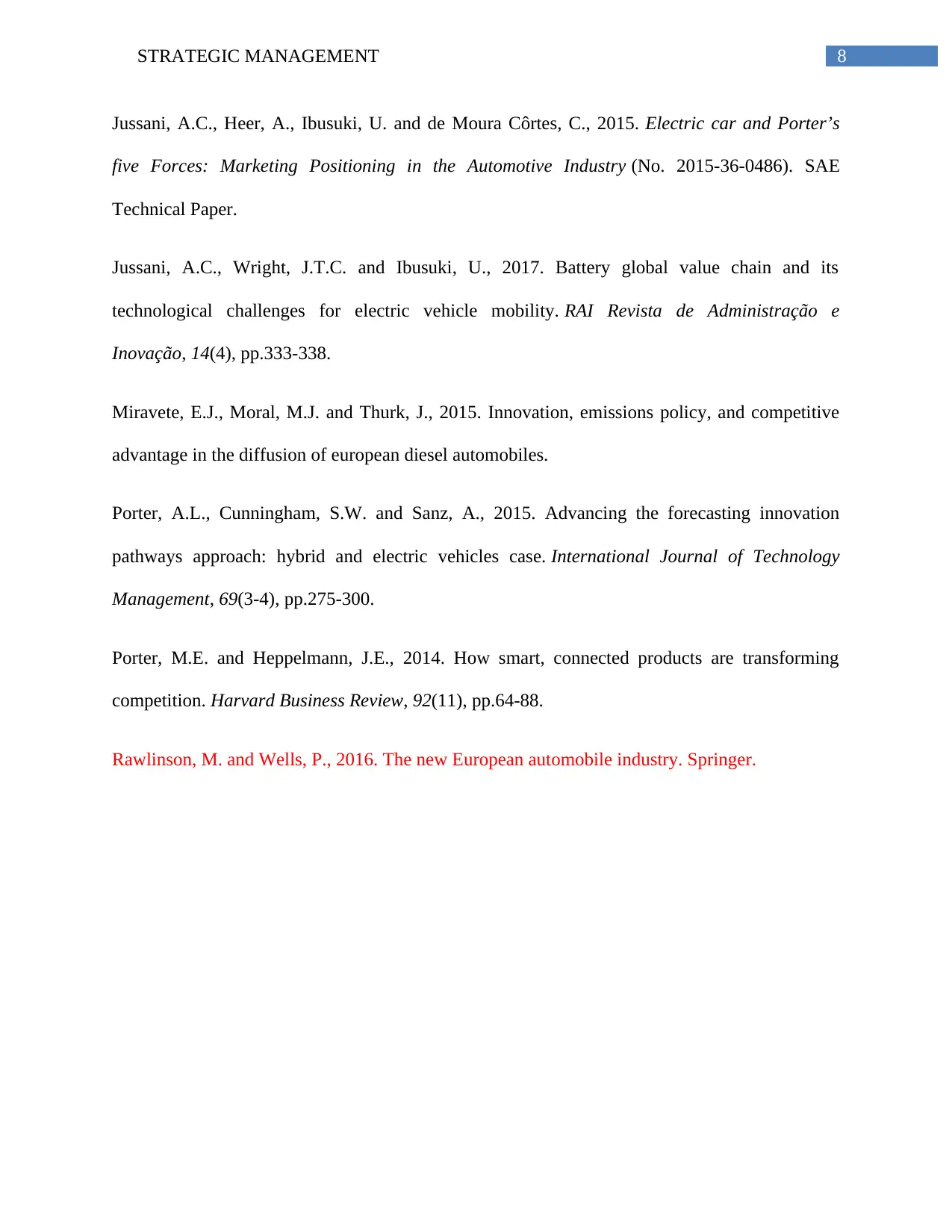
8STRATEGIC MANAGEMENT
Jussani, A.C., Heer, A., Ibusuki, U. and de Moura Côrtes, C., 2015. Electric car and Porter’s
five Forces: Marketing Positioning in the Automotive Industry (No. 2015-36-0486). SAE
Technical Paper.
Jussani, A.C., Wright, J.T.C. and Ibusuki, U., 2017. Battery global value chain and its
technological challenges for electric vehicle mobility. RAI Revista de Administração e
Inovação, 14(4), pp.333-338.
Miravete, E.J., Moral, M.J. and Thurk, J., 2015. Innovation, emissions policy, and competitive
advantage in the diffusion of european diesel automobiles.
Porter, A.L., Cunningham, S.W. and Sanz, A., 2015. Advancing the forecasting innovation
pathways approach: hybrid and electric vehicles case. International Journal of Technology
Management, 69(3-4), pp.275-300.
Porter, M.E. and Heppelmann, J.E., 2014. How smart, connected products are transforming
competition. Harvard Business Review, 92(11), pp.64-88.
Rawlinson, M. and Wells, P., 2016. The new European automobile industry. Springer.
Jussani, A.C., Heer, A., Ibusuki, U. and de Moura Côrtes, C., 2015. Electric car and Porter’s
five Forces: Marketing Positioning in the Automotive Industry (No. 2015-36-0486). SAE
Technical Paper.
Jussani, A.C., Wright, J.T.C. and Ibusuki, U., 2017. Battery global value chain and its
technological challenges for electric vehicle mobility. RAI Revista de Administração e
Inovação, 14(4), pp.333-338.
Miravete, E.J., Moral, M.J. and Thurk, J., 2015. Innovation, emissions policy, and competitive
advantage in the diffusion of european diesel automobiles.
Porter, A.L., Cunningham, S.W. and Sanz, A., 2015. Advancing the forecasting innovation
pathways approach: hybrid and electric vehicles case. International Journal of Technology
Management, 69(3-4), pp.275-300.
Porter, M.E. and Heppelmann, J.E., 2014. How smart, connected products are transforming
competition. Harvard Business Review, 92(11), pp.64-88.
Rawlinson, M. and Wells, P., 2016. The new European automobile industry. Springer.
⊘ This is a preview!⊘
Do you want full access?
Subscribe today to unlock all pages.

Trusted by 1+ million students worldwide
1 out of 9
Related Documents
Your All-in-One AI-Powered Toolkit for Academic Success.
+13062052269
info@desklib.com
Available 24*7 on WhatsApp / Email
![[object Object]](/_next/static/media/star-bottom.7253800d.svg)
Unlock your academic potential
Copyright © 2020–2025 A2Z Services. All Rights Reserved. Developed and managed by ZUCOL.





